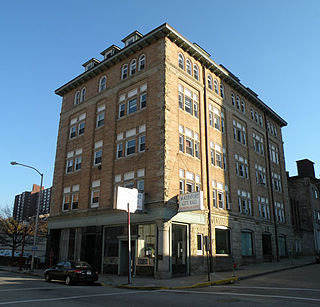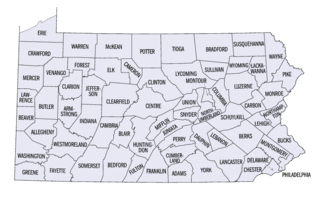
Allegheny County is located in the southwest of the U.S. state of Pennsylvania. As of the 2020 census, the population was 1,250,578, making it the state's second-most populous county, following Philadelphia County. The county seat is Pittsburgh. Allegheny County is included in the Pittsburgh, PA Metropolitan Statistical Area, and in the Pittsburgh Designated Market Area.

Duquesne is a city along the Monongahela River in Allegheny County, Pennsylvania, United States, within the Pittsburgh metropolitan area. The population was 5,565 at the 2010 census.

Homestead is a borough in Allegheny County, Pennsylvania, USA, in the Monongahela River valley 7 miles (11 km) southeast of downtown Pittsburgh and directly across the river from the city limit line. The borough is known for the Homestead Strike of 1892, an important event in the history of labor relations in the United States. The population of Homestead was 3,165 at the 2010 census.

Jefferson Hills is a borough in Allegheny County, Pennsylvania, United States. It includes the community of Large. In the 2010 census the population was 10,619. Jefferson Hills was created as Jefferson Township, incorporating on January 22, 1828, and named after Thomas Jefferson. The borough is a part of West Jefferson Hills School District. Before 1998, the borough was known as Jefferson.

McKeesport is a city in Allegheny County, Pennsylvania, United States; it is situated at the confluence of the Monongahela and Youghiogheny rivers and within the Pittsburgh metropolitan area. The population was 19,731 at the 2010 census, and is Allegheny County's third-largest municipality, after Penn Hills and Pittsburgh.

Munhall is a borough in Allegheny County, Pennsylvania, on the west bank of the Monongahela River, 8 miles (13 km) south of the confluence of the Monongahela and the Allegheny rivers where the Ohio River begins. It abuts the borough of Homestead.

West Homestead is a borough in Allegheny County, Pennsylvania, 8 miles (13 km) southeast of Pittsburgh, on the Monongahela River. Heavy industries associated with nearby steel mills existed here. Established were axle works, brickworks, and manufactories of machinery, car wheels, etc. The largest concern was Mesta Machinery which was one of the world's leading industrial manufacturers from 1898 until 1983. The population was 1,929 at the 2010 census.

The history of Pittsburgh began with centuries of Native American civilization in the modern Pittsburgh region, known as "Dionde:gâ'" in the Seneca language. Eventually, European explorers encountered the strategic confluence where the Allegheny and Monongahela Rivers meet to form the Ohio, which leads to the Mississippi River. The area became a battleground when France and Great Britain fought for control in the 1750s. When the British were victorious, the French ceded control of territories east of the Mississippi.

Downtown Pittsburgh, colloquially referred to as the Golden Triangle, and officially the Central Business District, is the urban downtown center of Pittsburgh. It is located at the confluence of the Allegheny River and the Monongahela River whose joining forms the Ohio River. The "triangle" is bounded by the two rivers. The area features offices for major corporations such as PNC Bank, U.S. Steel, PPG, Bank of New York Mellon, Heinz, Federated Investors and Alcoa. It is where the fortunes of such industrial barons as Andrew Carnegie, Henry Clay Frick, Henry J. Heinz, Andrew Mellon and George Westinghouse were made. It contains the site where the French fort, Fort Duquesne, once stood.

The Great Allegheny Passage (GAP) is a rail trail system in Maryland and Pennsylvania—the central trail of a network of long-distance hiker-biker trails throughout the Allegheny region of the Appalachian Mountains, connecting Washington, D.C. to Pittsburgh, Pennsylvania. It consists of several smaller trails including the Allegheny Highlands Trail of Maryland, the Allegheny Highlands Trail of Pennsylvania and the Youghiogheny River Trail.

Carnegie Steel Company was a steel-producing company primarily created by Andrew Carnegie and several close associates to manage businesses at steel mills in the Pittsburgh, Pennsylvania area in the late 19th century. The company was formed in 1892 and was subsequently sold in 1901 in one of the largest business transactions of the early 20th century, to become the major component of the United States Steel Corporation. The sale made Carnegie one of the richest men in history.

The Jones and Laughlin Steel Company began as the American Iron Company, founded in 1852 by Bernard Lauth and B. F. Jones, a few miles south of Pittsburgh along the Monongahela River. Lauth's interest was bought in 1854 by James Laughlin. The first firm to bear the name of Jones and Laughlin was organized in 1861 and headquartered at Third & Ross in downtown Pittsburgh.

This is a list of properties and districts listed on the National Register of Historic Places in Pennsylvania. As of 2015, there are over 3,000 listed sites in Pennsylvania. Sixty-six of the 67 counties in Pennsylvania have listings on the National Register; Cameron County is the only county without any sites listed.

The Carrie Furnace Hot Metal Bridge is a railroad truss bridge across the Monongahela River between Whitaker, Pennsylvania and Rankin, Pennsylvania. The bridge is out of service and it hasn't seen a train in almost 40 years.

The Union Railroad is a Class III switching railroad located in Allegheny County in Western Pennsylvania. The company is owned by Transtar, Inc., which is itself a subsidiary of Fortress Transportation and Infrastructure Investors, after being purchased from United States Steel in 1988. The railroad's primary customers are the three plants of the USS Mon Valley Works, the USS Edgar Thomson Steel Works, the USS Irvin Works and the USS Clairton Works.

Carrie Furnace is a former blast furnace located along the Monongahela River in the Pittsburgh area industrial town of Swissvale, Pennsylvania, and it had formed a part of the Homestead Steel Works. The Carrie Furnaces were built in 1884 and they operated until 1982. During its peak, the site produced 1,000 to 1,250 tons of iron per day. All that is left of the site are furnaces #6 and #7, which operated from 1907 to 1978, and its hot metal bridge. The furnaces, designated a National Historic Landmark in 2006, are among the only pre-World War II 20th century blast furnaces to survive.

The economy of Pittsburgh, Pennsylvania is diversified, focused on services, medicine, higher education, tourism, banking, corporate headquarters and high technology. Once the center of the American steel industry, and still known as "The Steel City", today the city of Pittsburgh has no steel mills within its limits, though Pittsburgh-based companies such as US Steel, Ampco Pittsburgh and Allegheny Technologies own several working mills in the Pittsburgh metropolitan area.

The Bost Building, also known as Columbia Hotel, is located on East Eighth Avenue in Homestead, Pennsylvania, United States. Built just before the 1892 Homestead Strike, it was used as headquarters by the Amalgamated Association of Iron and Steel Workers and for reporters covering the confrontation. It is the only significant building associated with the strike that remains intact. It is a contributing property to the Homestead Historic District. It was declared a National Historic Landmark in 1999.

The Three Rivers Heritage Trail is an urban rail trail paralleling the riverbanks in Pittsburgh, Pennsylvania and Allegheny County for about 33 miles (53 km), often on both sides of the rivers, and offering views of the city. The trail is promoted and maintained in part by the 'Friends of the Riverfront'. Their stated mission is to increase awareness and engagement with the region's rivers and riverfronts through activities and stewardship, and to extend the water and land trails on the major rivers within Allegheny County.


















